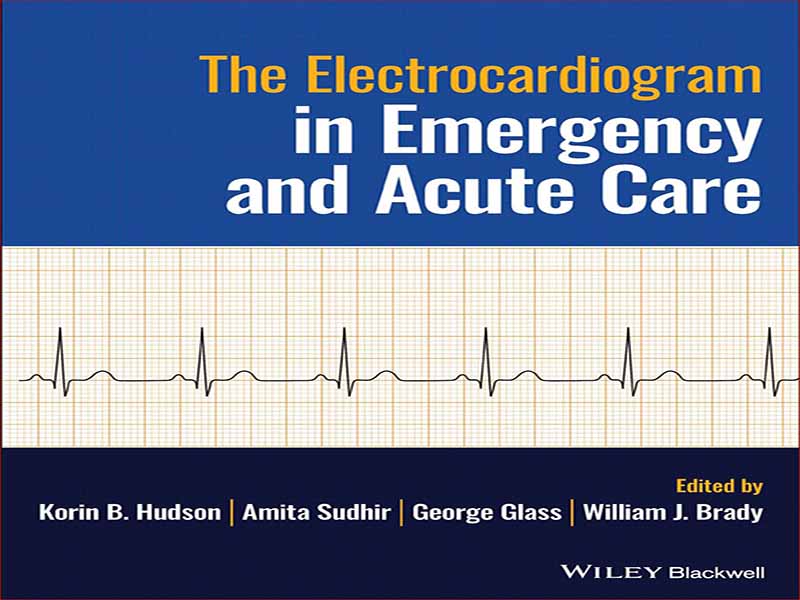- عنوان کتاب: The Electrocardiogram in Emergency and Acute Care
- نویسنده: William J. Brady
- حوزه: اورژانس
- تعداد صفحه: 224
- سال انتشار: 2023
- زبان اصلی: انگلیسی
- نوع فایل: pdf
- حجم فایل: 24.2 مگابایت
امروزه مانیتورینگ الکتروکاردیوگرافی یکی از پرکاربردترین تستهای تشخیصی در پزشکی بالینی است. اولین کاربرد آن برای بیمار در محیط های پیش بیمارستانی، در مطب پزشک یا توسط خدمات فوریت های پزشکی (EMS) رخ می دهد. . . استفاده از آن در بیمارستان ادامه دارد. الکتروکاردیوگرام، چه در حالت مانیتور با استفاده از مانیتورینگ ریتم تک کاناله یا چند کاناله و چه در حالت تشخیصی با استفاده از ECG 12 لید، ابزار شگفت انگیزی است. این به تشخیص، رد کردن بیماریهای مختلف، هدایت استراتژیهای تشخیصی و مدیریتی در ارزیابی، ارائه نشانههایی برای درمانهای خاص، ارائه ارزیابی خطر، و ارزیابی تأثیر اندام نهایی سندرم کمک میکند. همانطور که در این لیست چشمگیر از کاربردها اشاره شد، ECG بینش قابل توجهی در مورد وضعیت بیمار در طیف وسیعی از تظاهرات ارائه می دهد، خواه بیمار درد قفسه سینه با انفارکتوس میوکارد با افزایش قطعه ST (STEMI)، بیمار در ایست قلبی با تاکی کاردی بطنی، بیمار مسموم با برادی کاردی، یا بیمار نارسایی کلیوی با ریتم و یافته های مورفولوژیک سازگار با هیپرکالمی، در میان بسیاری، بسیاری از تظاهرات دیگر. این ابزار بسیار مفید غیر تهاجمی، قابل حمل، ارزان، به سرعت به دست آمده و به راحتی انجام می شود. با این حال، تفسیر ECG به راحتی انجام نمی شود و در واقع به مهارت و تجربه قابل توجه و همچنین آگاهی از محدودیت های پیرامون استفاده از آن نیاز دارد. این کتاب درسی برای کمک به پزشکانی که میخواهند مهارتهای مورد نیاز برای تفسیر الکتروکاردیوگرام را بیاموزند، مرور و اصلاح کنند و درک عمیقتری از استفاده از آن در طیف ارائهها و کاربردها ایجاد کنند، تهیه شده است. این کتاب درسی در پنج بخش تنظیم شده است. بخش 1 معرفی و بررسی مختصری از ECG در محیط بالینی است. بخش 2 بر روی تشخیص ریتم الکتروکاردیوگرافی متمرکز است و یافته های الکتروکاردیوگرافی را از منظر تشخیص افتراقی عمیق در نظر می گیرد – به عبارت دیگر، ریتم هایی با سرعت طبیعی و همچنین برادی کاردی و تاکی کاردی، که عرض و نظم پیچیده QRS را امکان پذیر می کند. بخش 3 ECG 12 لید را در بیماران مشکوک به سندرم حاد کرونری، از جمله انفارکتوس میوکارد با ارتفاع قطعه ST مرور می کند. بخش 4 دامنه ارائه های ویژه، جمعیت بیماران و موارد استفاده از الکتروکاردیوگرام را مورد بحث قرار می دهد. بخش 5 فهرستی از یافته های مختلف الکتروکاردیوگرافی، دوباره از دیدگاه تشخیص افتراقی است. در این بخش، ریتمها و تظاهرات مورفولوژیکی مختلف، مانند تاکی کاردیهای پیچیده باریک و گسترده و سندرمهای ارتفاع قطعه ST مورد بحث قرار میگیرند. این کتاب درسی به استفاده از ECG در اشکال مختلف آن توسط پزشکان در طیف وسیعی از تنظیمات بالینی می پردازد. الکتروکاردیوگراف تازه کار می تواند از این متن به عنوان مرجع ECG اولیه خود استفاده کند. علاوه بر این، مترجم با تجربه می تواند از این کتاب درسی برای گسترش پایگاه دانش خود استفاده کند. این کار بر ارزش ECG در طیف وسیعی از موقعیتهای بالینی که روزانه توسط ارائهدهندگان مراقبتهای بهداشتی با آنها مواجه میشوند، تأکید میکند – کاربردهای مناسب الکتروکاردیوگرام در سناریوهای مراقبتهای اضطراری و حاد را نشان میدهد. مهمتر از همه، این کتاب درسی توسط پزشکان برای پزشکان با تاکید بر واقعیت مراقبت از بیمار نوشته شده است. من و ویراستاران و نویسندگانم از ایجاد آن لذت بردهایم – امیدواریم که شما، پزشک، نه تنها از محتوای آن لذت ببرید، بلکه آن را در مراقبت از بیماران خود نیز ارزشمند بدانید. ما از شما برای کاری که هر روز انجام می دهید سپاسگزاریم.
Electrocardiographic monitoring is one of the most widely applied diagnostic tests in clinical medicine today; its first application to the patient occurs in the prehospital setting, in the clinician’s office or by emergency medical services (EMS) . . . its use continues on into the hospital. The electrocardiogram, whether in monitor mode using single or multichannel rhythm monitoring or in diagnostic mode using the 12‑lead ECG, is an amazing tool; it assists in establishing a diagnosis, ruling-out various ailments, guiding the diagnostic and management strategies in the evaluation, providing indication for certain therapies, offering risk assessment, and assessing end-organ impact of a syndrome. As noted in this impressive list of applications, the ECG provides significant insight regarding the patient’s condition in a range of presentations, whether it be the chest pain patient with ST segment elevation myocardial infarction (STEMI), the patient in cardiac arrest with ventricular tachycardia, the poisoned patient with bradycardia, or the renal failure patient with rhythm and morphologic findings consistent with hyperkalemia, among many, many other presentations. This extremely useful tool is non-invasive, portable, inexpensive, quickly obtained, and easily performed. Yet, ECG interpretation is not easily performed and, in fact, requires considerable skill and experience as well as an awareness of the limitation surrounding its use. This textbook has been prepared to assist clinicians who wish to learn, review, and refine the skills required to interpret the electrocardiogram and develop a deeper understanding of its use across the range of presentations and applications. This textbook is arranged into five sections. Section 1 is a brief introduction and review of the ECG in the clinical setting. Section 2 focuses on the electrocardiographic rhythm diagnosis, considering the electrocardiographic findings from an in-depth differential diagnostic perspective – in other words, rhythms with normal rates as well as bradycardia and tachycardia, allowing for the QRS complex width and regularity. Section 3 reviews the 12‑lead ECG in patients suspected of acute coronary syndrome, including ST segment elevation myocardial infarction. Section 4 discusses the range of special presentations, patient populations, and uses of the electrocardiogram. Section 5 is a listing of various electrocardiographic findings, again from the differential diagnostic perspective; in this section, various rhythm and morphologic presentations are discussed, such as the narrow and wide complex tachycardias and ST segment elevation syndromes. This textbook addresses the use of the ECG in its many forms by clinicians in a wide range of clinical settings. The novice electrocardiographer can use this text as his or her primary ECG reference; additionally, the experienced interpreter can use this textbook to expand his or her knowledge base. This work stresses the value of the ECG in the range of clinical situations encountered daily by health care providers – it illustrates the appropriate applications of the electrocardiogram in emergency and acute care scenarios. Most importantly, this textbook is written by clinicians for clinicians, with an emphasis on the reality of the patient care. I and my co-editors and authors have enjoyed its creation – we hope that you, the clinician, will not only enjoy its content but also find it of value in the care of your patients. We thank you for what you do every day.
این کتاب را میتوانید بصورت رایگان از لینک زیر دانلود نمایید.
































نظرات کاربران